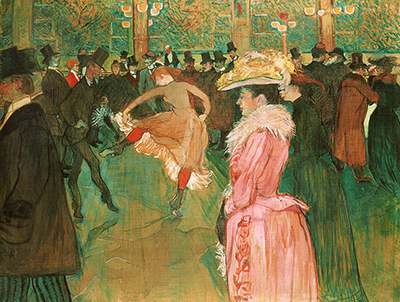At the Moulin Rouge, The Dance is an 1890 oil painting by Toulouse-Lautrec, featuring a vibrant scene of a dancing couple doing the can-can dance, in the Moulin Rouge. The Moulin Rouge is a nightclub and cabaret in Paris, which was established in 1889, of which Toulouse-Lautrec was a regular who was personally acquainted with many of its other patrons.
The dancing-couple focal point of the painting is somewhat immediately apparent, but this becomes a piece of art which perhaps transcends its visual graphic art classification, because of the natural movement of the typical viewer's eyes. Typically, viewers first notice the foreground which features a mysterious woman dressed in pink and then the eyes bounce off to the man wearing a bright red jacket in the background to finally fix upon the dancing-duo of Jacques Renaudin and Louis Weber. In this way, the onlooker’s dancing eyes allow them to live the scene beyond just the visual arts level, recreating the dancing that was going on.
Renaudin is smartly dressed in a black suit, with the outfit completed with a matching top-hat, while Weber's captured dancing motion reveals a pair of red socks which would probably otherwise be completely covered by her beige-orange dress had she not made for one half of the dancing focal point in motion. Jacques Renaudin was popularly known by his stage name, Valentin le Désossé, which translates to 'Valentin the boneless,' this in reference to his elasticity which came together beautifully with his slim build, and long arms and legs to account for his unmatched grace in performing the very expressive can-can dance.
Louis Weber was also popular as a dancer of that period and the official back story of the painting is that Valentin le Désossé is actually teaching Louis Weber how to perform some of the new moves of the can-can dance, since he was a star of the dance at the Moulin Rouge. Based on historical and contemporary knowledge of the appearance and layout of the Moulin Rouge, the scene depicted in the painting appears to be is lit up by the electric chandeliers hanging off the ceiling, providing more than enough light to offer a clear portrayal of a background group of smartly-dressed people, mostly comprised of men, who surround the dancing couple, converse, and hang around the bar.
This makes for the painting's justifiably lauded, beautiful composition, demonstrating the kind of skill which has been long in the making, as Toulouse-Lautrec worked hard from a young age to develop himself into the productive artist that painted this piece. As is the case with many of his other works, At the Moulin Rouge, The Dance featured a heavy influence of Toulouse-Lautrec's nightlife lifestyle, but in this particular piece he appears to be tipping the proverbial hat to the older Degas who was one of his style-and-genre influences. However,the scene is shifted from the Degaseque ballerina practice room to the dance hall of the Moulin Rouge.




